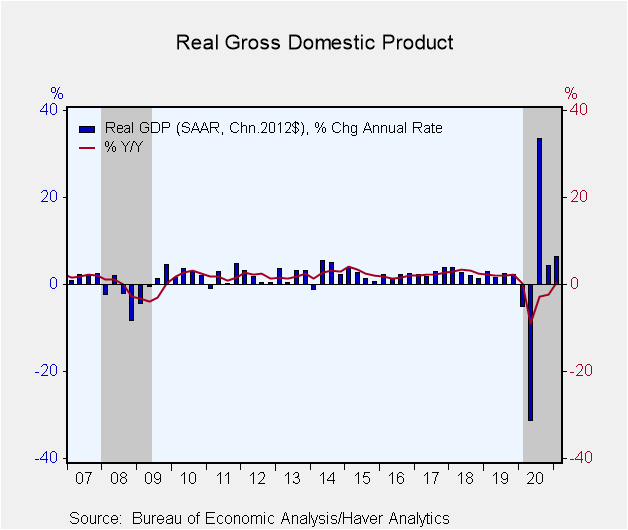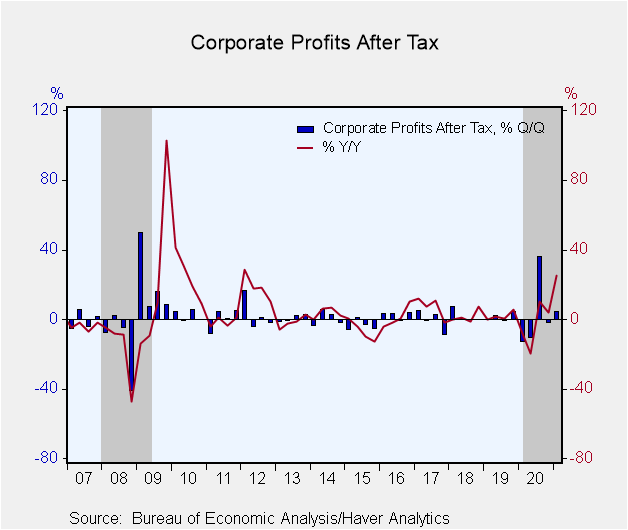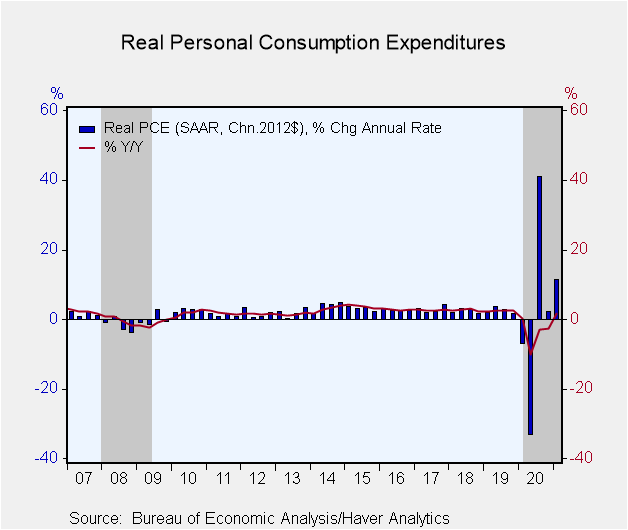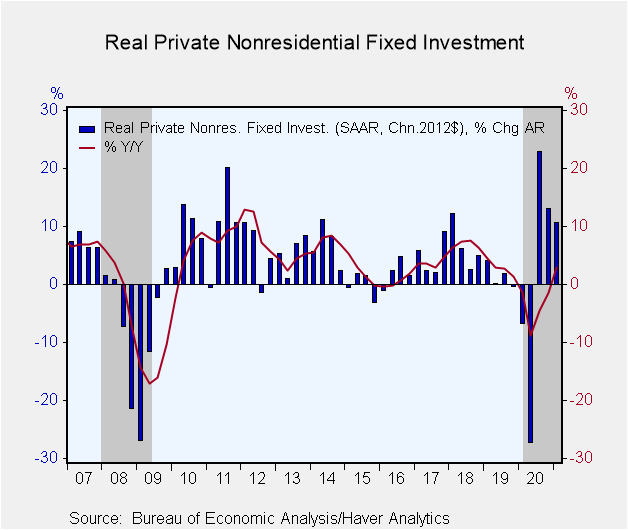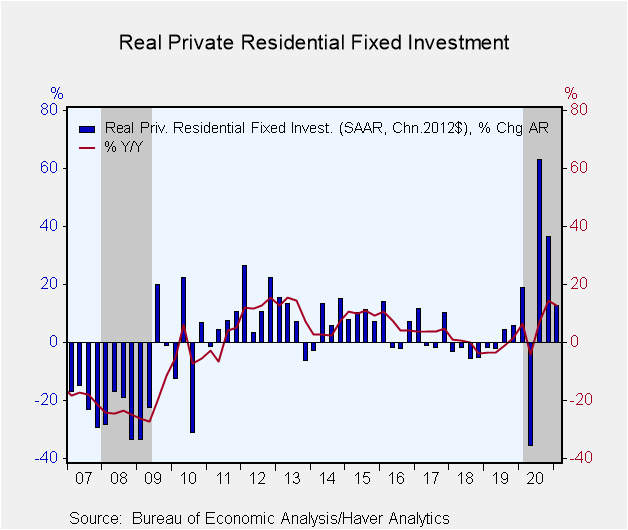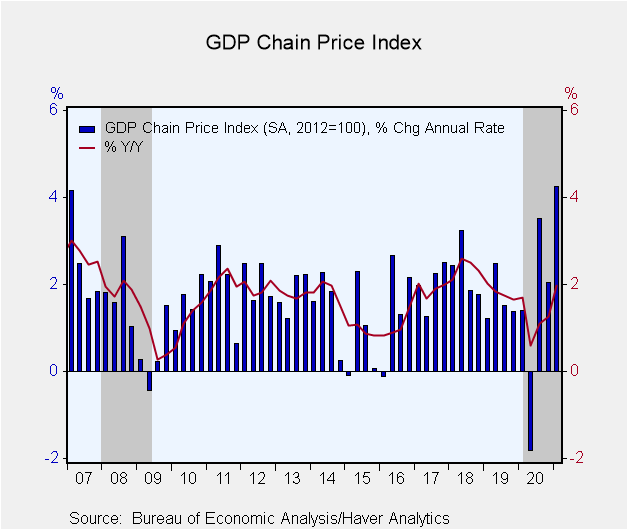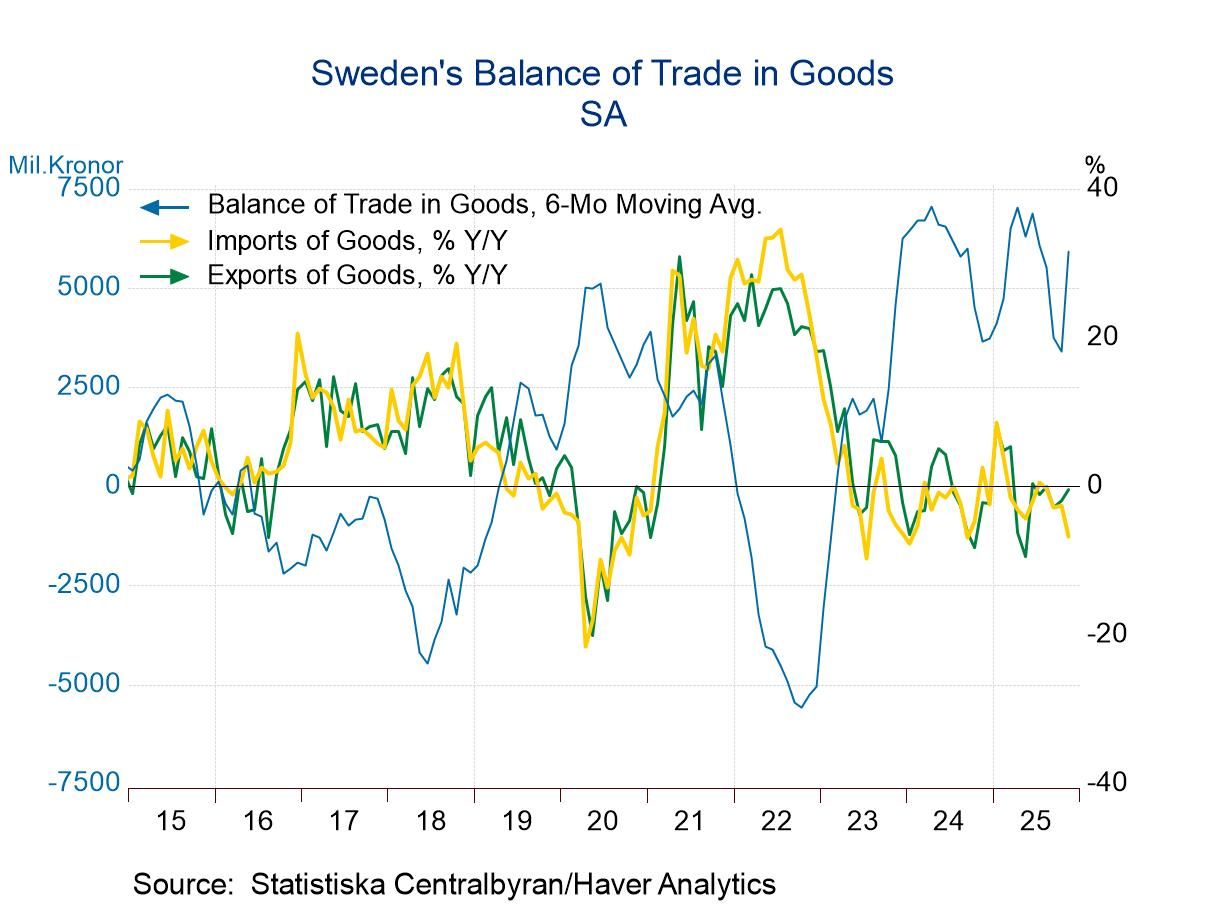 Global| May 27 2021
Global| May 27 2021U.S. GDP Growth Unrevised in Q1'21; Corporate Profits Rise Moderately
by:Tom Moeller
|in:Economy in Brief
Summary
• Consumer spending revised up while business & residential investment are strengthened. • Inventory & foreign trade effects are lessened. • Corporate profits improve. Real GDP surged 6.4% (SAAR) during Q1'21 (0.4% y/y), unrevised [...]
• Consumer spending revised up while business & residential investment are strengthened.
• Inventory & foreign trade effects are lessened.
• Corporate profits improve.
Real GDP surged 6.4% (SAAR) during Q1'21 (0.4% y/y), unrevised from last month's estimate, following a 4.3% rise during the Q4'20. A 6.5% gain had been expected in the Action Economics Forecast Survey.
Corporate profits after tax w/o IVA & CCA adjustments increased 4.6% last quarter (25.2% y/y) following a 1.7% decline in Q4'20. Before tax profits with IVA & CCA held steady (12.7% y/y). Nonfinancial sector earnings improved 0.9% (22.5% y/y) while foreign sector profits fell 2.1% (-10.1% y/y).
Domestic final sales growth was revised up to 10.3% (2.2% y/y) from 9.8%. Consumer spending growth was revised to 11.3% (1.8% y/y) from 10.7% following a 2.3% Q4 rise. Consumer durable goods spending growth was revised to 48.7% from 41.4% as motor vehicle buying increased by an upwardly revised 66.2%. Strength in furniture & appliance purchases as well as purchases of recreational goods & vehicles also were revised up. Nondurable goods spending rose a slightly lessened 14.0% (5.7% y/y) following a 1.6% decline in Q4'20. The 33.2% surge in clothing outlays was little revised and food & beverage outlays gained a little-revised 15.1%. Outlays on services increased 4.6% (-3.3% y/y) which also was little changed. Restaurant & hotel spending surged 26.6% while recreation outlays strengthened 28.1%, strong for the third straight quarter. Outlays on housing & utilities improved 1.8%.
Business fixed investment strengthened 10.8% (2.9% y/y), revised from 9.9%, the third straight quarter of strong growth. Structures investment fell a deepened 5.7%, the sixth straight quarter of sharp decline. Equipment investment surged 13.4% following two quarters of even stronger growth. Information processing equipment grew a lessened 24.8% but the 16.9% jump in intellectual property was lifted from the initial report.
Residential investment surged 12.7% (12.8% y/y), revised from 10.8%, to the highest level since the first quarter of 2007.
Government spending increased 5.7% (0.6% y/y), revised from 6.3%. It was, nevertheless, the strongest increase since Q2 2009. Federal government spending surged 13.9% while state & local expenditures rose 1.8% following three straight quarterly declines.
Inventory decumulation reduced GDP growth by 2.8 percentage points, revised from -2.6% points, following two quarters of accumulation. International trade deficit deterioration reduced GDP growth by an increased 1.2 percentage points, revised from -0.9. Exports fell an increased 2.9% while imports rose a strengthened 6.7% following two quarters of even stronger gain.
GDP price data were unrevised. The chain price index rose 4.1% (1.9% y/y), the strongest gain since Q1'07. The rise in the PCE price measure advanced by 3.5% (1.7% y/y) while the business fixed investment price index rose 0.5% (0.4% y/y) after a 0.2% gain. The residential investment price index surged 11.4% (7.0% y/y) while the public sector price index strengthened 6.2% (2.4% y/y), equaling the largest gain since early 2007.
The GDP figures can be found in Haver's USECON and USNA database. USNA contains virtually all of the Bureau of Economic Analysis' detail in the national accounts. Both databases include tables of the newly published not seasonally adjusted data. The Action Economics consensus estimates can be found in AS1REPNA.
| Chained 2012 $ (%, AR) | Q1'21 (2nd Estimate) | Q1'21 (Advance Estimate) | Q4'20 | Q3'20 | Q1'21 Y/Y | 2020 | 2019 | 2018 |
|---|---|---|---|---|---|---|---|---|
| Gross Domestic Product | 6.4 | 6.4 | 4.3 | 33.4 | 0.4 | -3.5 | 2.2 | 3.0 |
| Inventory Effect (%-point) | -2.8 | -2.6 | 1.4 | 6.6 | 0.0 | -0.6 | 0.0 | 0.2 |
| Final Sales | 9.4 | 9.2 | 2.9 | 25.9 | 0.5 | -2.9 | 2.2 | 2.8 |
| Foreign Trade Effect (%-point) | -1.2 | -0.9 | -1.5 | -3.2 | -1.6 | -0.1 | -0.2 | -0.3 |
| Domestic Final Sales | 10.3 | 9.8 | 4.4 | 29.8 | 2.2 | -2.7 | 2.3 | 3.0 |
| Demand Components | ||||||||
| Personal Consumption Expenditure | 11.3 | 10.7 | 2.3 | 41.0 | 1.8 | -3.9 | 2.4 | 2.7 |
| Nonresidential Fixed Investment | 10.8 | 9.9 | 13.1 | 22.9 | 2.9 | -4.0 | 2.9 | 6.9 |
| Residential Investment | 12.7 | 10.8 | 36.6 | 63.0 | 12.8 | 6.1 | -1.7 | -0.6 |
| Government Spending | 5.7 | 6.3 | -0.8 | -4.8 | 0.6 | 1.1 | 2.3 | 1.8 |
| Chain-Type Price Index | ||||||||
| GDP | 4.1 | 4.1 | 2.0 | 3.5 | 1.9 | 1.2 | 1.8 | 2.4 |
| Personal Consumption Expenditure | 3.5 | 3.5 | 1.5 | 3.7 | 1.7 | 1.2 | 1.5 | 2.1 |
| Less Food & Energy | 2.3 | 2.3 | 1.3 | 3.4 | 1.5 | 1.4 | 1.7 | 2.0 |
| Nonresidential Investment | 0.5 | 0.5 | 0.2 | 0.1 | 0.4 | 0.5 | 1.3 | 0.9 |
| Residential Investment | 11.4 | 11.4 | 6.5 | 9.5 | 7.0 | 3.3 | 2.8 | 5.6 |
Tom Moeller
AuthorMore in Author Profile »Prior to joining Haver Analytics in 2000, Mr. Moeller worked as the Economist at Chancellor Capital Management from 1985 to 1999. There, he developed comprehensive economic forecasts and interpreted economic data for equity and fixed income portfolio managers. Also at Chancellor, Mr. Moeller worked as an equity analyst and was responsible for researching and rating companies in the economically sensitive automobile and housing industries for investment in Chancellor’s equity portfolio. Prior to joining Chancellor, Mr. Moeller was an Economist at Citibank from 1979 to 1984. He also analyzed pricing behavior in the metals industry for the Council on Wage and Price Stability in Washington, D.C. In 1999, Mr. Moeller received the award for most accurate forecast from the Forecasters' Club of New York. From 1990 to 1992 he was President of the New York Association for Business Economists. Mr. Moeller earned an M.B.A. in Finance from Fordham University, where he graduated in 1987. He holds a Bachelor of Arts in Economics from George Washington University.


